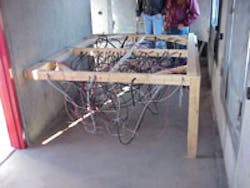In 1999 21 of the 112 deaths (18%) of the deaths were due to entrapment. This wasthe second leading cause of fatal injuries to firefighters. “The increased number offirefighter fatalities in 1999 and the diverse circumstances of those deaths are soberingreminders that fire fighting remains one of today’s most physically and mentally-demanding jobs”, says Gary Tokle. The year 2008 the trend in the number firefighters trapped is significantly down. The risks of the job however have not lessened.
Lets examine to see why entrapment is so prevalent of a statistic, especially with the
common practices of Rapid Intervention Teams in today’s fire service. There is one case that comes to mind almost immediately, Adams Way, Memphis Tennessee. Firefighters their became trapped by wiring and other devices that fell from the ceilings of the apartment building. I can think of two that have direct effects on myself where as I was the one who was trapped. Trapped by hanging wires that had fallen from the ceiling during fire operations. The fact is that many of these wires are extremely small and hard to see.Just what produces these wires and where do they come from. Most buildings today
have either dropped ceilings or sheet rocked ceilings. Behind these areas is a vast number of electrical wires, electronic networking systems, telecommunication networks, and the non-obvious flexible heat ducts. All of these even though they are normally hidden come out of hiding when the integrity of the ceiling is lost due to fire, water or other fire ground operations. Under smoke conditions they are not easily detected until you as a firefighter engaged in operations have found yourself tied up and a hostage of these entrapment hazards. So how do we get loose from this entangling maze? There are several ways; forced yourself loose, cut your way free or undo the tangled web that you have woven.Firefighters each year potentially loose their lives due to being unable to get free from these hanging obstacles. The use of a small pair of wire cutters is a fast and efficient way to free the wiring from your person. The knives with serrated edges will cut most of these wires. So what happens if you loose these tools during operations or you get tied up and can’t reach them? This is one area we do not address often enough, the training of self-survival techniques with out the extra advantages of tools. I am a firm believer that if you can free yourself through dis-entanglement then you are surly able to free yourself
with a few added tool advantages. But how do we train people in this skill? One way is through development of training aids or props. Here you can see a prop that I designed for use in Self-Survival Training and Rapid Intervention Team Training. As firefighters we are destined to found ourselves all tied up. The key aspect is to be able to facilitate our own escape. Building a Disentanglement SimulatorBuilding a prop is easy. First do you want it to be portable or stationary? If you want to be able to move it from place to place you must think of the ergonomics of moving the prop. In the development of this particular prop I acquire a cage off of a silo and cut it at 8 feet. Two people easily move this cage and could even have wheels put on it. May industrial plants may have these laying around in salvage areas due to the change in the standards that doesn’t allow the ladder rungs to be made with rebar steel. These older caged ladders were removed. Once a cage is found or built the simulation part of fallen wires is next. In this case small gauge rope utilized by boaters for tying up was used. This style of rope was chosen for its flexibility. Then loop the rope in your own design tying the loops with clove hitches to facilitate the assistance of disentanglement should an emergency arise with the student. Each time this prop is assembled it is a different maze if you want it to be. To accomplish this just simply rearrange the rope configuration.
What if your needs are for a permanent simulator. Well those are not difficult either. Just take a look at the simulator used at Massachusetts Firefighting Academy. It is designed to be stored up against the wall. During specific exercises the instructor can easily lower it to the floor and you now have changed the scenario instantly. The simulator is nothing more than a frame with a legs on one side and the other side secured to the wall on hinges to facilitate the movement from stored to being in active use. Again this simulator can be utilized at the three difficulty levels mentioned earlier.
Training with the SimulatorThe object of this is not to have the student cut their way through, but to have them attempt to get through without becoming tangle. One area that has been reciprocated time and time again in evaluating firefighters is the ability to know and work with their Personal Protective Equipment (PPE). If the student becomes tangled in the simulator they should manipulate their PPE. The most come piece of PPE that becomes tangled on wires is the SCBA. The firefighter should remove or doff the SCBA and untangle the entrapment hazard and move to safety. Once at a safe location, free of entanglement hazards, the Firefighter will then don the SCBA. This exercise can be administered in 3 levels of difficulty. The low difficulty level is in a lighted atmosphere without any visual imparities. Moderate Level is done with visual impairments such as darkness or non-toxic training smoke. The Hardest level we add the external factor of heat to the moderate level. A kerosene torpedo heater in area can raise the temperature considerably to simulate the effects of fire without the extreme risks or the toxic smoke.
Students should always begin at the lowest levels and work up. The mastery of self-survival skills is imperative to the survival of firefighters.
About the Author

Doug Cline
Douglas Cline, is a 28-year veteran and student of the Fire Service serving as Training Commander with the High Point (NC) Fire Department. Cline also serves in the position of Administrative Assistant Chief with the Ruffin Volunteer Fire Department.
Cline, a former Fire Chief, is a North Carolina Level II Fire Instructor, National Fire Academy Instructor and an EMT-Paramedic instructor/coordinator for the North Carolina Office of Emergency Medical Services. Cline is a member of the North Carolina Society of Fire Service Instructors and the International Society of Fire Service Instructors where he serves on the Board of Directors as the First Vice President. Cline also has on the FEMA grant criteria development committee, peer reviewer for the Fire Act Grants, the Northern Director for the Piedmont North Carolina Fireman’s Association, Piedmont Director for the North Carolina Fallen Firefighters Foundation and Southeastern Association of Fire Chief’s Conference planning committee. Chief Cline also serves as Second Vice President of the Southeastern Division of the International Association of Fire Chiefs.
Cline was honored as the International Society of Fire Service Instructors (ISFSI), 1999 George D. Post International Instructor of the Year. Cline is also a member of National Association of EMS Educators (NAEMSE). He holds a Bachelors Degree in Social Services with a Minor in Education from Concord University.
Cline is a well known international speaker presenting dynamic power packed programs on instructor development, officer development, rapid intervention team training and firefighter safety and survival. Cline also is a highly published author with the most recent publications being with Thomson-Delmar Learning. The Publications are the Company Officer Test Preparation Guide Book with a scenario training DVD. Chief Cline is the technical content advisor for the Rapid Intervention Team Book published by Thomson-Delmar Learning and contributing author to the instructor support materials for the Rapid Intervention Team Book published by Thomson-Delmar Learning, test bank developer for the Fire Department Incident Safety Officer Book and contributing author to the instructor support materials for the Rapid Intervention Team Book published by Thomson-Delmar Learning. Chief Cline has also been a contributing author and reviewer to several of the IFSTA and Brady Emergency Medical Technician texts.
Cline hosts the monthly “Training and Tactics Talk” pod cast on Firehouse.com. Cline also has multiple training videos with the Fire Emergency Training Network (FETN) and American Heat to include, Rapid Intervention Team Training, Vehicle Fires, Hose line Management, Emergency Vehicle Operations and Fire Ground Safety and Survival. Cline is also a contributing editor to Firehouse.com and The Pennsylvania Fireman Magazine.
